|
|
Area/Range |
|---|---|
|
|
37.66120°N / 119.173°W |
|
|
Mountaineering, Trad Climbing, Scrambling |
|
|
Spring, Summer, Fall |
|
|
12264 ft / 3738 m |
|
|
Overview
The Minarets are one of the most striking mountain features in all of the Sierra Nevada. This large collection of pinnacles rises sharply from its surroundings, creating an incredibly serrated skyline in the heart of the the Ansel Adams Wilderness. There is a fine view of the Minarets from the summit of Mammoth Mountain, a popular ski resort in the Eastern Sierra. They can also be seen (albeit briefly) from US395 while driving between Bishop and Mammoth Lakes. The Minarets are part of the Ritter Range, the remnants of an ancient volcanic massive that predates most of the Sierra granite. Nearby Mt. Ritter, the highpoint of the range, along with Banner Peak dominate the area for views and sheer size, but it is the Minarets that bring that special combination of inspiration, respect and a bit of fear to the hearts of mountaineers.
The chain of lakes including Minaret, Cecile, Iceberg and Ediza adorn the east and north sides of the Minarets like a set of pearls - true gems of the High Sierra. The spectacular peaks and photogenic lakes combine to create a truly magnificent area. Once a part of Yosemite National Park, it was detached in 1905 over conflicts with mineral rights. Since then it has become part of the Ansel Adams Wilderness, and is once again protected from further development. Because of its volcanic origin, the rock does not have the solid features found in granitic areas and has acquired a reputation for being loose. Much of the underlying rock is quite solid, but there is a good deal of loose talus strewn about and it is this that one must be most careful about. A helmet should be considered mandatory and large parties are to be avoided.
There are 17 minarets that have been named after one of the first ascensionists (in a few cases a person from the second ascent to avoid duplication). While both Ritter and Banner were climbed in the 19th century, the Minarets did not see activity until the 1920's. Charles Michael, a Yosemite postmaster, along with his wife Enid were the first to record an ascent in 1923 of Michael Minaret. Over the next ten years most of the remaining minarets were climbed by various parties involving many of the famous climbers of the era, including Norman Clyde, Walter Starr, Jules Eichorn and Glen Dawson, among others. In 1948, Dyer Minaret was the last (and most difficult) of the group to be climbed. In 1933, Walter Starr's son went missing on a solo trip to the area. An intense search ensued, culminating in the discovery of his fallen body high on the slopes of Michael Minaret. His body was interred where it lay, and still rests there to this day.
Today, there are dozens of routes among the many pinnacles, but the reputation for poor rock quality keeps most enthusiasts away. The picturesque lakes that lie on the approach routes are very popular with backpackers, but only a small portion of the visitors venture to the summits of the Minarets where solitude and a grand sense of adventure are certain to be found.
Getting There
There are two trailheads to access the Minarets, both about eight miles distance to the base of the Minarets on good trails. Both are located along SR203, west of Mammoth Mtn resort in the town of Mammoth Lakes. From US395, drive west through Mammoth Lakes on SR203, turning right at the second traffic light. Drive three miles up to the main lodge of Mammoth Mtn ski/bike resort. Depending on the time of day, you must either take a shuttle bus from this point or you may be able to drive further if you are there early in the morning or late in the evening. See the Red Tape section for more info. Agnew Meadows is the more scenic of the two approaches.
From one of two parking areas for backcountry visitors, take the trail down to the San Joaquin River and follow the Shadow Lake Trail up to Ediza Lake. The views of Ritter and Banner from Shadow Lake along this trail are truly memorable, as is the view of the Minarets from Ediza Lake. From Ediza Lake, cross-country routes lead to Ritter Pass, The Gap, and North Notch for access to the west side of the Minarets. Or you can follow a diminishing trail up to Iceberg Lake and an even fainter one around the east side of the lake and up to Cecile Lake. This last part is often over steep snow even late in summer and crampons are usually a good idea. Cecile Lake is at the base of Clyde Minaret, the most popular Minaret destination. Devils Postpile is the other TH access to the Minaret area.
From the ranger station, follow the trail across the San Joaquin River, turn north for a few miles, then follow the Minaret Lake Trail west to Minaret Lakes. This trail is sandy in the lower stretches and often hot on warm days. This trail is better as a descent route, and combined with an approach starting from Agnew Meadows, makes a fine loop route (you can take the shuttle bus for free from Devils Postpile back to Agnews Meadow). In the event that SR203 is closed, you can still reach the Minarets, but you'll have more walking to do.
If the road is closed at Minaret Summit (usually in spring), you have 2.6mi (downhill) to Agnew Meadows and another 4mi past that to Devils Postpile. If the road is closed at Mammoth Mtn (usually in winter) you have an additional 2mi (uphill) to Minaret Summit. You are almost assured of having the entire Ansel Adams Wilderness to yourself if you choose to do these extra miles at these times.
A Brief Climbing Guide
Clyde Minaret - 12,261ft, class 3-4 The Southeast Face (IV, 5.8) is considered a Sierra classic. The most popular route is the Rock Route, one of the most sustained class 3 routes in the Sierra (with one class 4 move). There are a number of other class 3-5 routes on this side facing Cecile Lake.
Eichorn Minaret - 12,255ft, class 4 Though the second highest, Eichorn Minaret isn't very minaret-like, instead it is the highpoint along the ridge extending west from Clyde Minaret. The traverse between the two is the easiest route, and a fine climb. Drop low on the SE side as you approach Eichorn to avoid class 5 along the jagged ridgeline. It is also class 4 from the Portal.
Michael Minaret - 12,240ft, class 4-5 This is an excellent class 4 scramble from the Portal. Pass through the portal to the east side, make an airy traverse around the overhanging east side, then scramble up the north and northwest sides of Michael Minaret to the summit. This minaret looks impossibly steep when viewed from Clyde Minaret's summit. Rice Minaret - 12,160ft, class 4 Take the left branch up Starr's Chute. The traverse from Bedayan, done on the west side of the ridge, is class 3.
Bedayan Minaret - 12,080ft, class 4 The Northwest Chute, leading to the notch north of Bedayan, is class 4. The traverse from Rice Minaret is class 3.
Adams Minaret - 12,000ft, class 3 There are two summits spaced far apart - the east summit is the highpoint. From South Notch, you can climb a broad class 2 chute on the East Face (with a class 3 headwall/ramp to the summit ridge), followed by an easy scramble to the summit (class 3 summit blocks). Alternately, scramble up from the Michael-Adams Notch, around the west side of the lower west summit, then on to the east summit. The NW Ridge between the two summits is an excellent class 4 climb with wild exposure.
Dawson Minaret - 11,920ft, class 5 A complicated climb from North Notch. See Secor's description for details.
Ken Minaret - 11,760ft, class 3-4 There are two summits close to each other - the NW summit is the highpoint. The easiest route is on the Southwest Face, with the crux found at the summit blocks. From the north side of Amphitheater Lake, climb a steep, shallow chute up and slightly left of the summit. Land on the crest to the NW of the summit and head right to the summit. Two class 4 cracks/chimneys are near the summit. If you try to climb directly to the summit from the SW side you will find class 5 rock in the last 50 feet. The ridge from South Notch is class 5 as is the NE Face.
Jensen Minaret - 11,760ft, class 5.4-5.8 Four pitches of loose 5.7-5.8 climbing from North Notch. NE Face is 5.4 via the right-hand chimney.
Waller Minaret - 11,711ft, class 5.2 The first ascent via the Eichorn Route is 5.4. An easier, but more complicated route up the West Ridge is 5.2. The Eichorn Route is reached from The Gap while the West Ridge and 5.4 West Side are most easily reached from Ritter Pass.
Dyer Minaret - 11,680ft, class 5.6 This is the most difficult of the minarets. The NW Face is 5.6, the East Face is 5.7. Both routes start from North Notch.
Turner Minaret - 11,600ft, class 4 The traverse from Jensen Minaret is class 3. The East Face is 5.8, the East Side is 5.4.
Leonard Minaret - 11,600ft, class 4 It is class 4 on the West Ridge from The Gap, as is the Southeast Rock Chimney and the South Face.
Starr Minaret - 11,512ft, class 2-3 An easy scramble from the Kehrlein-Starr Notch. Easier climbing to the right, stiffer class 3-4 if you stick to the ridgeline.
Kehrlein Minaret - 11,440ft, class 4 A short but enjoyable scramble from South Notch. Climb the ridge until cliffs block progress, then move to the northwest side where the crux across some slabby ledges is found.
Pridham Minaret - 10,960ft, class 2 This is the easiest of the Minarets. It is class 2 from the Pridham-Riegelhuth Notch, or class 3 from the west. Mostly a talus heap, it is the least interesting as well.
Riegelhuth Minaret - 10,560ft, class 4 This is a striking pinnacle from either Minaret or Cecile Lake. The West Face from the Pridham-Riegelhuth Notch is a short but challenging route. From the notch, scramble up to a ledge leading into the wide NW Chute about a third of the way up (this is more difficult if you try to enter the chute from the bottom). Scramble up the chute on thin ledges to the summit (Secor calls this a trough on the West Face).
Passes
There are a number of passes that cross the Minarets, all of which can be used to gain access to the Minaret of choice. Most of the north or northeast sides of these passes have snow year-round and crampons/axe are advised. Most of these passes are class 2, without significant route-finding issues.
Ritter Pass is the easiest route across the Ritter Range. It is also a bit inconvenient for approaches to the Minarets with the exception of Waller Minaret, and not often used by climbers.
The Gap is a prominent class 2 notch between Waller and Leonard Minarets. The northeast side has a permanent snowfield, axe/crampons advised. The southwest side is easy boulder/talus and leads to the west side of the Minarets. This is the best approach for climbs such as Michael's Chute and Starr's Chute on the west side of Michael and Eichorn Minarets.
North Notch is a less-obvious route across the range between Jensen and Dyer Minarets. The route is class 3 from the north side where a chockstone is encountered just below the notch, and crampons/axe are usually needed. The west side is steep talus.
Adams-Michael Notch, located between these two minarets, is class 2-3 on both the east and west sides. This notch is used for the easiest route up Adams Minaret.
The Portal, between Michael and Eichorn Minarets, is not really a pass or even a good way to cross the range, but it is a prominent landmark for climbs of these two minarets. The east side of the portal is Amphitheater Chute, a difficult 5.6 climb with horrendously loose talus. The west side is class 4-5 via Michael's or Starr's Chute.
South Notch, class 2, is the second easiest way across range, located beween Ken and Kehrlein Minarets. The route is obvious from the outlet of Cecile Lake, and leads to the south side of the range with access to Amphitheater Lake and Starr, Kehrlein, Ken, Adams, and Michael Minarets. The south side is easy talus. The north side usually has snow, but the angle is low enough to avoid crampons/axe if the snow is sufficiently soft.
Kehrlein-Starr Notch provides access from Pridham Minaret to the other minarets around Amphitheater Lake. The west side is easy, but the east side is steep and narrow. If filled with snow it is a steep but straightforward climb, otherwise the difficulty will exceed class 3 (rap slings can be found on this side of the notch).
Kehrlein-Pridham Notch, class 2, provides access to the west side of Pridham Minaret.
Pridham-Riegelhuth Notch, class 2-3 is the usual route to reach these two minarets. The north side is narrow and steep and usually requires crampons/axe.
Red Tape
SR203, the only access to the area, has restrictions to motor vehicles during the summer months that it is open. Avalanche danger and heavy snowfall close the access road for more than half the year. See the Eastern Sierra Logistical page for more details on hours and fees.
Learn More
Additional route information for all the Minarets can be found in greatest detail in RJ Secor's book, The High Sierra: Peaks, Passes, and Trails. Other useful references are: Climbing California's High Sierra, Moynier and Fiddler The Good, the Great, and the Awesome, Croft This latter describes a superb effort by Peter Croft to climb 16 of the minarets in a single 22hr day (Waller Minaret is left out). This amazing feat was repeated again in 2002 by Josh Shwartz in just under 17hrs. It has also been reported that Jason Lakey made a complete traverse (16 peaks) in one day in Aug 2006.


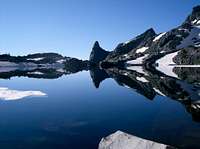
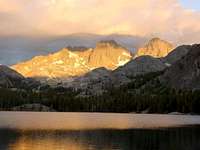
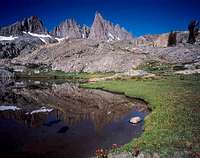
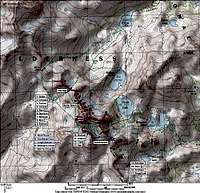

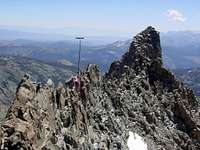



lavaka - Sep 22, 2008 11:31 am - Hasn't voted
traverse in a dayIn addition to Peter Croft and Josh Shwartz, Jason Lakey also made a complete traverse (16 peaks) in one day in May 2006.
Bob Burd - Sep 22, 2008 9:58 pm - Hasn't voted
Re: traverse in a dayThanks - I've added that to the text. Do you know how long he took and where he started/ended (that is, was it a TH, or a camp near one of the lakes)?
lavaka - Sep 23, 2008 10:31 am - Hasn't voted
Re: traverse in a dayUnfortunately I don't know much else. It was August, not May (I read a 5 as an 8 earlier). All I know is what he wrote in the Leonard summit register, which was "8/06 complete Traverse of Minarets. 16 summits solo in a day, Jason Lakey" A fellow named Aiden made a traverse on 9/11/08, soloing (presumably) the SE Face of Clyde and traversing from there over.